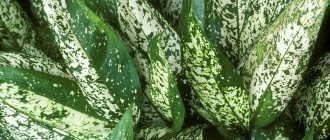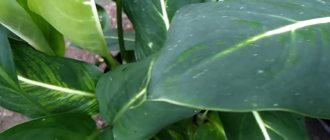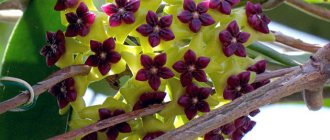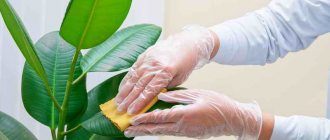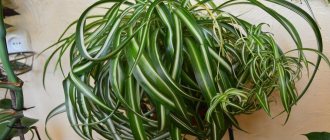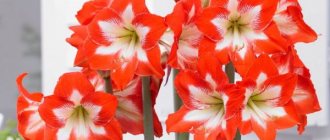Dieffenbachia is an evergreen plant that is of interest to those who like to decorate apartments and garden plots. The flower was named in honor of Joseph Dieffenbach, who served as the head gardener of the Austrian Imperial Botanical Garden in the 19th century. Thanks to its variegated leaves, the plant is often used as an indoor plant. However, its poisonous properties cast doubt on the advisability of such a neighborhood.
What kind of plant is this, is it possible to keep Dieffenbachia at home, how is it dangerous for humans and is there any benefit from it? - let's find out. And also what to do if your skin or eyes are burned by Dieffenbachia juice and if you have food poisoning.
Where to put a flower in the house
It is better not to place it in the bedroom so that it does not contribute to the emergence of quarrels and conflicts. The optimal place in the house is the kitchen. This room is imbued with feminine energy, which the flower loves so much. Having received enough “food”, the plant will not be “naughty”, but will only delight with beauty and positive energy.
Dieffenbachia is good at cleaning space from negativity. If you place a flower in an unfavorable zone, it will constantly be busy absorbing flows of negative energy.
Where else can Dieffenbachia take root? In an office or training room. By strengthening your business acumen and helping to solve problems, the flower will help improve your work and learning.
By following these recommendations, you can safely bring Dieffenbachia into the house. A bright, colorful, unusual flower will decorate any room, filling it with freshness and green colors! The main thing is to remember that it must have its own correct place, which will make it work for the benefit and not the detriment of the homeowners.
Harm of Dieffenbachia
Despite the usefulness of Dieffenbachia, some people have a question: is it poisonous or not? Indeed, the plant is poisonous. Substances with toxic properties are contained in the milky juice of Dieffenbachia. If the juice gets on a person’s skin, it instantly causes a burn.
It is much more dangerous if the poisonous juice gets into the mucous membrane of a person’s eyes or mouth
Such carelessness can lead to blindness and swelling of the tongue (in the latter case, the person loses the ability to speak for some time)
Growing Dieffenbachia in a house with small children
Careless handling of the plant can cause serious health problems, so deciding whether Dieffenbachia can be grown at home must be done wisely. It is not recommended to purchase a flower for those who have small children or pets in their home.
If there is already Dieffenbachia in the house and a child is born, then it is necessary to limit the baby’s contact with the plant - hang the flower from the ceiling, place it on a high stool or fence it off with a fence.
Harm of Dieffenbachia to pets
Dieffenbachia juice can cause poisoning and even death to pets. A peculiarity of cats is the desire to taste the leaves of indoor flowers. Dogs often imagine the trunk of large plants as playing sticks, so they try to gnaw or bite them. All this can lead to poisoning of the animal or to burns on the oral mucosa.
To prevent an animal from being poisoned by a poisonous flower, it is necessary not to leave them unattended. If your pet is left alone at home, it is recommended to close the doors of the room where Dieffenbachia grows.
Fortunately, adult dogs and cats are able to independently determine which plants may pose a danger to them. As a rule, adult animals try not to approach or have any contact with the poisonous plant.
Is Dieffenbachia poisonous: can you keep it at home or not?
There is an opinion that appearances are often deceiving - this statement completely coincides with the description of Dieffenbachia. Underneath the beautiful appearance lies a poisonous juice, which provokes swelling and burns, and is also a trigger for the development of a severe allergic reaction.
After contact of the liquid contained inside with the mucous membrane of any living organism (eyes, nose, mouth), the place of contact burns and swells. These phenomena are so strong that a person temporarily becomes blind and mute.
It is not surprising that a person can end up in the hospital after contact with the juice of this plant
An exception to this rule are people with individual intolerance: the patient develops an allergy, which in some cases provokes the development of heart failure.
It is recommended to use rubber gloves during any manipulation. At the end of the work, the limbs should be thoroughly washed with soap.
For children and pets , who are most susceptible to poisoning because they are curious about any interesting object, the poison has a stronger effect .
In the house where they live, it is better to refuse to raise a tropical pet. As a last resort, Dieffenbachia can be kept in inaccessible places.
Is it harmful only during flowering?
The shrub enters the flowering phase extremely rarely. The flowers of a poisonous tropical plant are not particularly beautiful.
Biologists are confident that flowers are completely safe for humans. Despite this, they recommend that gardeners trim the shoots on which the flowers form. Flowering negatively affects the condition and appearance of Dieffenbachia - the plant weakens greatly, and in some cases even sheds its leaves.
The level of toxicity does not depend on whether the plant blooms or not, since the milky sap contains substances harmful to humans all year round.
Harm to humans
If the juice of the plant gets on the skin of an adult, it will cause ulcers that will soon go away, but in children they will take a longer time to heal. In some cases, it may cause vomiting or painful cramps. It has been proven that this shrub cannot cause serious problems for humans, but it can harm your pets. For example, if the sap of a plant gets into a cat's larynx, it can cause swelling, which will block the air supply and the animal may die.
In America, during slavery, slaves were punished with this plant by forcing them to chew a leaf of the bush - this did not lead to death, but the punished person was speechless. So this plant acquired another name “mute rod”.
Allergy to Dieffenbachia
What to do if Dieffenbachia juice gets on your skin and causes an allergic reaction? Symptoms can be divided into local and general.
If a localized rash, itching, or blisters appears, take antihistamines and monitor the body's reaction. If further development of symptoms does not occur, then the following conclusions should be drawn:
- the impact was local;
- next time the reaction will be more violent and unpredictable.
General symptoms occur with the development of acute respiratory and cardiovascular failure. The severity of the condition requires immediate hospitalization and intensive care in the intensive care unit.
Signs and superstitions: is it possible to keep Dieffenbachia at home?
By believing in various signs and superstitions, we pay tribute to the irrational that sits deep in each of us. Some, especially mystical people, tend to see signs in everything. What do the signs say about keeping Dieffenbachia in the house?
"Muzhegon", flower of celibacy
People really attribute to Dieffenbachia a negative impact on the personal life of its owner. It is believed that if a woman is single, having Dieffenbachia, she will not be able to get married. But the one who has already created family happiness for herself may lose it. Superstitious people claim that a woman will definitely get divorced or become a widow.
Therefore, it is advisable to plant this flower only for those who do not believe too much in superstitions. Having gone through your friends in your mind, you will probably remember prosperous married couples in whose house Dieffenbachia lives. But you should not purchase this plant with fear in your soul - in this case, it will not give you joy.
If it blooms
It is believed that any flower, living in a house, establishes an energetic connection with it and with everyone living there. At home, Dieffenbachia blooms very rarely, so the flowering that occurs is considered an event. According to the sign, this event occurs when psychological discomfort and tension increase in the house. The flower seems to be giving you a sign that favorable changes are necessary, that it is time to stop quarrels or silent confrontation.
Why does Dieffenbachia cry?
This plant has the ability to anticipate weather changes and can serve as an excellent barometer. On the eve of heavy rains and snowfalls, Dieffenbachia will announce their appearance with transparent droplets protruding on the bright leaves. The flower appears to be crying, but this is a normal quality that should not bother you. On the contrary, experienced flower growers are grateful to Dieffenbachia for the hint whether to take an umbrella with them when leaving the house or not.
Why can't you keep it in the office?
Some are so afraid of Dieffenbachia that they avoid its presence not only at home, but also in the office. And completely in vain. It is precisely with its powerful energy that the plant fuels the team, mobilizes employees to work and is considered most suitable for office and industrial premises with large crowds of people.
Precautionary measures
In order for Dieffenbachia to bring only joy, it is necessary to take special care when caring for the flower and when replanting it:
- When pruning a plant or tearing off spoiled leaves, you should wear rubber gloves.
- You can only replant a flower while wearing gloves.
- You should not put a pot with a plant in a children's room, especially if the children are small and like to try everything.
- The flower should be in a place inaccessible to pets;
- After caring for the flower, wash your hands thoroughly with soap.
- If plant juice accidentally gets into the eyes, the mucous membrane is washed with running water.
- If the juice gets on the skin, it is also washed thoroughly and antihistamines are taken.
- If part of the Dieffenbachia has been swallowed, you need to rinse the victim’s stomach and give sorbents and antiallergic drugs.
If, after accidentally eating part of a houseplant, symptoms of laryngeal edema appear, you should urgently call a doctor!
Dieffenbachia is considered one of the most unpretentious indoor flowers.
Dieffenbachia juice is poisonous due to the alkaloids it contains. However, few adults will chew parts of the plant, so the risk of poisoning is minimal. Such a plant should be kept away from small children and pets, and then it will bring nothing but benefit.
Dieffenbachia is one of the most common indoor plants. It can often be found in offices and apartments. However, there are many negative reviews about this flower. Is Dieffenbachia really a poisonous plant? What is the danger of a flower for humans and animals?
Dieffenbachia propagation methods:
- Through air layering.
- By cuttings.
- Seeds.
- When transplanting, you can divide the plant if it is a bush variety.
Let's look at each method in more detail, and you can decide for yourself which one is more suitable for your case.
- If the plant is already old, or the roots have rotted, then you can cut off the top and place it in water or a bowl with peat, after mixing it with sand. Direct sun should not hit the cuttings. Be sure to moisturize by spraying water from a spray bottle. The trunk with the crown cut off is cut off so that 10 centimeters remain. The cut part of the stem can be divided into pieces so that each has buds. They are dried and placed on top of peat and sand. The kidney is located at the top. Cover the top with film. The temperature should be maintained at approximately 22 degrees. When rooting occurs, the plants should be replanted.
- Dieffenbachia has air layering, which is also used as propagation material. An incision is made on the shoot, around which it is necessary to wrap moistened moss, and cover the top with a piece of film. In a humid environment, roots appear quickly. At this point the cutting should be cut and planted.
- If the plant blooms, then propagation is possible by sowing seeds. Female flowers are partially closed. To carry out pollination, you need to make an incision on it. Using a soft brush, take pollen from a male flower and transfer it to a female one. Then the incision is sealed.
Why is Dieffenbachia dangerous?
Dangerous is the milky sap, which contains toxins and their effects begin to appear literally within seconds, so it is important to act immediately to stop the poisoning. When figuring out why the Dieffenbachia flower is dangerous, it is worth noting that if the leaves are swallowed, swelling of the larynx and painful shock may occur.
This is especially dangerous for children and animals, who cannot report the problem, so there is no way to quickly help them. There is a scheme of action for Dieffenbachia poisoning:
- The victim should drink a lot of warm water, milk or a weak solution of potassium permanganate.
- A person must take a sorbent to neutralize and remove dangerous substances from the body.
- After this, you should definitely consult a doctor to prevent the development of serious consequences.
Dieffenbachia flower - poisonous or not?
The danger comes from the milky sap, which can be seen, for example, if you tear off a leaf. When describing whether Dieffenbachia is dangerous for humans, it is worth noting that direct contact of the juice with the skin can cause an allergic reaction, dermatitis, rashes, and even ulcers. Interestingly, American planters used this crop as a tool to punish slaves. To avoid this, you need to wear gloves when transplanting and wiping leaves.
Dieffenbachia, how does allergy manifest itself?
Rarely, but cases of an allergic reaction to shrubs have been recorded. It has the same symptoms as, for example, dust, citrus fruits and the like. An allergy to Dieffenbachia causes a dry cough and/or runny nose that cannot be relieved for a long time. In addition, itching occurs and the eyes begin to water. You can cope with it with the help of conventional medications.
History of the introduction of Dieffenbachia into culture
There are about 50 species of Dieffenbachia in the world, mainly growing in South America. These plants belong to the Araceae family. The genus is famous for its decorative deciduous evergreen crops, the main advantage of which is its large variegated leaves.
After the discovery of America, during the development of previously unknown lands of Oceania and the Caribbean, plants from new territories often ended up on neighboring islands and the mainland. That’s right, with the ships of traders and pirates, Dieffenbachia was brought to the south of what is now the United States, Tahiti, Hawaii, the Cook Islands and other tropical areas. Then the culture was delivered to Europe.
Thanks to their powerful shoots, dense succulent foliage and unpretentious disposition, soon after their appearance on the shores of the Old World, the plants became desirable in greenhouses, and then settled on the windowsills of houses.
Over the past time, Dieffenbachia has never become the culprit of serious poisoning or death of people. At least, neither the press nor doctors mentioned whether Dieffenbachia is poisonous or not.
On the American continent, the picky plant adapted so well and quickly to new conditions that in many places it became a real weed. Here no one thought of keeping Dieffenbachia in pots, but even in the open ground it never revealed its harmfulness. Unless it gradually displaces native species, occupying the best places and lands under the warm sun.
What is Dieffenbachia's fault? Is it possible to keep it at home or is it better to get rid of powerful green pets with beautiful foliage?
Doubts about the benefits and harms of Dieffenbachia arose in the 20th century, when scientists studied the composition of the greenery not only of this culture, but also of other representatives of the Araceae.
Calcium oxalates were found in all parts of these plants, which have an irritating effect on the skin and mucous membranes of the eyes, respiratory organs and digestive tract. In some species the content of potentially hazardous substances was negligible, in others it was many times higher.
The popular name of the flower and the origins of superstitions associated with it
Dieffenbachia is popularly called the “flower of celibacy.” According to signs, she poisons family relationships, places a curse on spouses, which causes quarrels, scandals and betrayals. According to the ancestors, the flower deprived the couple of the opportunity to have children, and placed a wreath of celibacy on an unmarried girl.
Some people had a different point of view. They believed that the plant, on the contrary, absorbs negative energy. Thanks to this, the spouses will be able to create a strong and reliable union. Today it is impossible to clearly answer why, in the opinion of our ancestors, we should not keep Dieffenbachia at home.
Beneficial features
Dieffenbachia is often decorated with homes and offices not only because of the aesthetic side of the issue. This ornamental plant has many advantages, which are little known among the people. People often discuss the poison of the flower rather than its beneficial properties. The beneficial properties of the plant include:
- The ability to improve the chemical composition of air in the home. This is explained by the fact that the flower can not only absorb, but also neutralize toxic substances.
- Dieffenbachia has a detrimental effect on many pathogenic microorganisms in the air, thereby reducing the incidence of illness in people;
- Dieffenbachia grows only in humid climates, so the air in the room where it stands is always humidified. Which is especially good for asthmatics and allergy sufferers.
Dieffenbachia is recommended for people who live in environmentally polluted areas, for example, near factories and furniture factories. This plant neutralizes formaldehyde well and protects humans from its harmful effects.
Some experts believe that Dieffenbachia is capable of leveling out background radiation in the room where it grows.
Dieffenbachia care
A tropical plant requires special living conditions. The most important marker is high air humidity. Dryness kills the flower, causing the leaves to turn yellow and dry out.
The leaves require special care. When dirty, clean the surface with a cloth soaked in boiled water. Spraying from a spray bottle is carried out every few days.
The flower requires plenty of watering
Important! The soil should dry out. Overdrying the substrate is destructive, as is overmoistening
When leaving for a long time, the flower must be entrusted to neighbors or friends. Lack of long-term care is like death.
Basic rules for caring for Dieffenbachia:
Lighting. Bright diffused light without direct sunlight. If there are blinds on the windows, either side will do. In dark rooms, additional artificial lighting will be needed.
Air temperature. In summer up to 30 degrees. In winter - not lower than 16 degrees. The absence of drafts is an important vital sign!
Watering. In summer - plentiful. In winter – moderate. Only boiled or settled water is used.
Air humidity. From 65%. In summer, the plant can be sprayed; in winter, clothes can be dried on radiators, especially if the flower is on the windowsill. The ideal support option is a humidifier. Bathing with running water is advisable, but on condition that the water does not get into the pot.
Feeding. Regular – once every one to two months
Important! The fertilizer must not contain lime. The amount of solution should be half the amount recommended by the manufacturer. Transplantation during spring - from March to May.
Pests
The flower suffers from the abundant attention of aphids, scale insects, thrips, spider mites, and mealybugs.
An interesting feature of Dieffenbachia
The plant can “cry”. Transparent drops sometimes appear at the tips of Dieffenbachia, falling from the leaves especially intensely before rain. Other aroids have the same property, including philodendron and monstera. Sometimes a plant may “cry” after heavy watering. If you notice this, dry the soil and avoid frequent waterlogging. This can harm the plant: it will rot. Overmoistening is most dangerous during autumn and winter.
Myths and superstitions
Almost every house plant has some kind of signs associated with it. It is recommended to place some flowers in your home to improve family or financial well-being, health and aura. Others, on the contrary, cause fear and cause harm to a person. Often, such statements have nothing to do with reality and are only speculation and fiction.
Dieffenbachia is the flower around which debates about its benefits and harms do not subside. Some of them reach complete absurdity, others are quite understandable.
Superstitions associated with growing plants at home:
- Lack of money in the house. It is believed that in a home where a flower grows, material well-being disappears. People who previously lived in abundance begin to experience an acute shortage of means of subsistence;
- The eternal theme is fathers and sons. People say that with the appearance of a plant in the house, problems begin between parents and children. Misunderstandings and quarrels constantly haunt such families;
- Dieffenbachia - “man racer”. It is believed that an unmarried girl should not be taken to a young man’s house if this flower grows there. The relationship will not lead to anything good. Such unions are usually short-term, unpromising, and subsequent separations are painful. Legend has it that the variegated pet is trying with all its might to eliminate the male sex from the apartment. Even long-married people have quarrels and discord due to misunderstandings;
- Treason. The destruction of a family can occur due to the husband’s “spree.” The husband is looking for love and affection on the side, from which the woman suffers and remains alone;
- Deterioration in the quality of intimate life. They say that a flowerpot with a plant cannot be placed near the marital bed. This leads to male sexual impotence, disrupts the usual peace in the family and destroys it;
- Lack of heirs. It is believed that long-awaited children are less likely to appear in a house where there is Dieffenbachia. The flower disrupts the aura in the house, impairs fertility;
- Loneliness. Powerful negative energy has a negative effect on guests. People experience discomfort more often, quickly leave their home, and no longer want to come to their owners;
- Bad aura. The plant has such negative energy that constant scandals, quarrels, and litigation arise in the house, even out of nowhere;
- Scares away animals. Pets rarely take root in such apartments. They are more likely to get sick, run away, or die;
- Energetic vampire. Some people believe that the flower “sucks out” a person’s positive energy and health. This causes the owners to get sick more often, react sharply to changing weather conditions, experience headaches, fatigue, and do not get enough sleep.
To believe or not in folk signs is everyone’s business. But reviews from experienced flower growers indicate that most of them are nothing more than fiction and speculation.
A little about the flower
At home, this exotic shrub in some cases grows only 50-70 cm, sometimes up to 1.5 meters. In its homeland, in the American tropics, it grows up to 2 meters.
The plant attracts the eye with its beautiful leaves, which can sometimes reach up to 50 cm, with white streaks, sometimes with yellow and light specks. Dieffenbachia grows very quickly, in the process of gaining height it sheds its lower leaves, its trunk becomes bare and as a result loses its attractiveness. Therefore, skilled and experienced gardeners trim the top.
In nature, when a plant reaches two meters, the trunk cannot stand it under the weight of gravity and bends towards the ground. New shoots appear, and the plant thus reproduces.
It almost never blooms in the home or office; in nature it blooms every year. Its flowers do not strike with particular beauty, resembling a yellowish cob, which is covered with a kind of fluffy blanket.
Signs
Since ancient times, people have believed that Dieffenbachia destroys family life or prevents the creation of a family.
It was believed that a girl who has this flower growing in her house will never be able to get married. She will either have difficulties in relationships, or all romances will turn out to be frivolous and fleeting. If a woman already has a relationship or is married, then Dieffenbachia can bring discord into a couple and even lead to divorce.
The plant, according to popular belief, destroys male energy. The popular names of Dieffenbachia are “old maid’s flower”, “widow’s flower”, and also “celibacy flower”. Since Dieffenbachia is an energy vampire, it is believed that people living next to it will constantly feel irritability, malaise, and stress.
Headaches, unpleasant dreams or insomnia, neurotic conditions, and interruptions in cardiac activity often appear. It is believed that the flower also has a negative effect on family finances if kept in a residential area. Dieffenbachia in the bedroom has a detrimental effect on cash flow, leading to unexpected expenses and poverty.
Many signs indicate that Dieffenbachia has a detrimental effect on male potency and destroys intimate life in a couple, contributing to male infertility
This plant is exclusively female, and it can cause harm to men. The flower has a negative impact on men: loss of strength, misunderstanding in relationships with his wife, health problems and difficulties at work.
The plant also has a negative effect on domestic animals, namely cats.
The sign says that if you bring Dieffenbachia to a house where a cat lives, the pet will soon run away. The poisonous flower does not get along well with other plants in the neighborhood. It is best not to place it next to other flowers, but to choose a separate place.
It is believed that placing Dieffenbachia with another plant means divorce in the family. An evergreen pet can also warn about various negative events. The leaves have become dull and lethargic - a sign of parting with a loved one. Dieffenbachia withers - a serious illness.
According to popular belief, families who keep a dangerous plant in their house will be childless. For various reasons, the couple will not be able to conceive a child.
Many will argue with this statement and say that they have seen families who have Dieffenbachia growing at home and at the same time have children, but this does not mean that such a plant should be kept in the apartment and, especially, placed in the bedroom.
There are also positive beliefs associated with the poisonous plant; it is important to simply choose a suitable place for it, away from the marital bed.
Poisonous or not?
Is Dieffenbachia poisonous to humans? Currently, there is no accurate information about the serious toxicity of the plant. However, all aroid species are considered relatively poisonous. Dieffenbachia parts contain toxic juice. In case of contact with the skin and mucous membranes, burns and severe irritation occur.
Young children and pets most often suffer from poisoning. They often try unfamiliar objects, which can result in the development of intoxication. People who have Dieffenbachia in their home are advised to know the characteristic symptoms of poisoning.
Signs:
- presence of headache and dizziness,
- stomach pain, nausea,
- inability to talk,
- swelling of the mouth and larynx,
- respiratory disorder,
- redness, irritation of the skin.
This condition is dangerous for allergy sufferers due to the possible development of Quincke's edema and respiratory impairment. If signs of poisoning appear, the victim must be given first aid.
What to do:
- Rinse the stomach of a poisoned person.
- Give a large amount of water and milk to drink, this will reduce the concentration of toxin in the body.
- The injured person is given sorbents to speed up the removal of the poison.
- If the toxin gets on the skin and mucous membranes, thoroughly wash the affected area with clean water and apply Rescuer or Panthenol cream.
- A person is given antihistamines to prevent the development of allergic reactions.
- If necessary, contact a medical facility.
If a child or animal is poisoned, a visit to the hospital is required. It is not recommended to self-medicate victims with allergic reactions to avoid negative consequences.
Folk signs and superstitions regarding Dieffenbachia
Dieffenbachia as an instrument for torture
Can you suffer from Dieffenbachia? In the modern world, this plant no longer poses a serious danger, but in the 19th-20th centuries the flower acquired a very bad reputation.
Everyone knows that in the old days, instruments of torture were very sophisticated. Dieffenbachia also found a very original use. The stems of the wild plant were cleared of leaves and used as “fiery rods”, the blows of which caused inflamed cuts and severe burning. They also used the leaves of the flower, forcing the victim to chew and swallow them thoroughly. Ultimately, swelling of the larynx occurred, which deprived the person of the ability to breathe and he died in terrible agony.
Flower of celibacy
There are many folk signs associated with Dieffenbachia. One of the most common is the so-called “flower of celibacy.” There is an opinion that the plant prevents marriage or meeting a soul mate, and dooms one to loneliness.
Is it possible for already married couples to keep Dieffenbachia in the bedroom? Popular opinion says that this plant has negative energy that can destroy marriage bonds and provoke troubles and misfortunes.
Dieffenbachia has poisonous juice
Description of indoor flower
Dieffenbachia belongs to a subspecies of tropical plants. The special charm of the flower is in its unusually colored leaves. They have a lush green color with white stripes or splashes. An adult flower can reach a height of 2 meters.
But it is necessary to clarify that with age it loses its grace, as the lower leaves fall off, exposing a strong, thick trunk.
Dieffenbachia can often be found in offices, large stores, museum halls, and even in educational classrooms. Many indoor flower lovers grow Dieffenbachia at home. But the plant can cause enormous harm to humans if it is not provided with proper care.
- In order for Dieffenbachia to be healthy, strong and beautiful, it needs to create comfortable conditions. The plant grows well at an air temperature of 17-18 degrees Celsius. It does not like sudden changes in temperature, as well as bright lighting.
- Sunlight on the surface of the leaves causes a superficial burn. As a result, the leaves become covered with rusty spots, gradually dry out and crumble.
- Dieffenbachia requires moderate watering and regular cleaning of the leaves from dust and surface contaminants. Water for watering the plant should be at room temperature. Ideally, it will be settled water.
- About once a week it is recommended to wipe the Dieffenbachia leaves with a damp soft cloth.
- The plant also responds positively to regular spraying. Water for spraying should also be at room temperature.
- Do not allow liquid to remain in the tray of the pot after watering. You should also not overwater the flower. Excessive soil moisture will lead to the development of serious diseases or even the death of the plant.
Description
The photos of the poisonous Dieffenbachia and its description given in the article will help you understand in general terms what kind of flower it is and why many, despite assumptions about its toxicity, still keep this beauty and love it very much.
The plant is native to the tropics of South America. More than forty species have been described by botanists to date. The assortment offered in flower shops makes it possible to acquire several different options. All Dieffenbachia are characterized by rapid development and growth. The beauty is in no hurry to bloom, and it is not very reasonable to expect gorgeous buds from it: all the beauty is in the leaves. The flower is a spadix with a light green covering leaf.
Frequently asked questions about Dieffenbachia
Beginning flower growers have many questions related to plant transplantation, care and placement in the apartment. People start a flower, and then only begin to become interested in the conditions of its maintenance, compatibility with other plants, and energy effects. Dieffenbachia is a difficult plant to care for and on a mental level. It doesn’t suit all people, it doesn’t find a common language with everyone.
Muzhegon and the flower of celibacy
Popular rumor ascribes to the plant the ability to “repel” representatives of the stronger sex.
There is an opinion that if an unmarried lady acquires Dieffenbachia, she will not be able to count on personal happiness. If there is a man in the house, he will leave or, even worse, die.
Bad omens do not come true if you do not believe in them. When you spit convulsively over your left shoulder at the sight of a black cat, you admit the thought that something bad will happen. And the Universe immediately throws up negative options for the development of events
Try to pass by without paying attention to the black beast, you will see that nothing bad will happen!
Why does Dieffenbachia “cry”
In fact, this is a figurative expression. The plant, as mentioned above, is an excellent natural barometer. It reacts sensitively to the slightest changes in weather. Before prolonged downpours and snowfalls, droplets of moisture appear on the leaves of Dieffenbachia. You should not be afraid of this phenomenon; it only heralds an increase in the concentration of water in the air. Use this feature to know exactly whether you need to take an umbrella when leaving the house.
Where to put the plant
The space where people sleep is not the best place for Dieffenbachia. At night, it actively releases carbon dioxide, so the next morning a person will feel sick.
This applies to all plants with large leaves; they are appropriate in the living room, kitchen and other places where you spend the daytime.
To believe the signs or not is a personal matter. I don't believe in bad omens, but I don't get a plant because I have a cat and a dog. Responsible pet owners will never choose this flower.
A little about the author:
Ksenia Likhachevskaya Tarot reader Esoterics for me is a universal key that opens many doors behind which new knowledge, opportunities and prospects are hidden. More than 20 years ago I first picked up Tarot cards. Since then I have used them for more than just predictions. The world of Tarot is an amazing reality, immersing yourself in which you will find answers to questions and be able to change your life. Tarot reader services
Interesting:
- Fortune telling2019.08.13Tarot horoscope for September 2022 for Capricorns
- Fortune telling2019.08.13Tarot horoscope for September 2022 for Aquarius
- Fortune telling2019.08.13Tarot horoscope for September 2022 for Pisces
- Fortune telling2019.08.13Tarot horoscope for September 2022 for Aries
Tags: Ksenia Likhachevskaya, Signs
Pests and diseases of Dieffenbachia
Insects and Dieffenbachia diseases
The most common insects that attack Dieffenbachia are spider mites, scale insects, aphids, thrips and mealybugs. Methods to combat them include mechanical removal of pests with a damp sponge soaked in a soap solution, followed by washing off the soap with plenty of water. In case of severe infection, treat with a solution of actellik or karbofos in a proportion of 15 drops per liter of water.
Sometimes Dieffenbachia suffers from bacteriosis, which is expressed in the appearance of watery areas on the leaves with clear boundaries. Unfortunately, this disease is bacterial in nature and is incurable. An adult plant can also be destroyed by root rot, which first affects the underground part of the plant and then the above-ground part. As soon as you notice areas with a light gray coating, take immediate action: reduce watering, replace the substrate, treat with a systemic fungicide.
Dieffenbachia turns yellow
Very often, amateur gardeners ask the question why Dieffenbachia leaves turn yellow. Let's start with the fact that if you followed all the rules for caring for the plant, you would not have to find out why Dieffenbachia turns yellow, since proper care makes the plant invulnerable to diseases and pests. But in life, anything happens, so let’s clarify this issue.
First of all, in such cases, the suspicion falls on a violation of the temperature regime: either the room is too cold, or the plant was standing in a draft. Another possible cause is watering the plant with too hard water or a lack of nutrients in the soil. Dieffenbachia leaves turn yellow due to root rot.
Dieffenbachia dries out
Often our readers also ask why Dieffenbachia dries. If the lower leaves dry out, turn yellow and fall off, then this is a natural process, which, unfortunately, cannot be prevented, and if the trunk is very bare, then it is time to rejuvenate the Dieffenbachia by cuttings. But if young leaves dry out, this is most likely due to insufficient watering for a long time, cold air or drafts.
Dieffenbachia withers
If the leaves are drooping and the substrate is dry, you are not watering the plant often, but if the substrate is wet and the leaves are drooping, check the roots for rot. If it is found, clean the roots from the soil, remove rotten areas with a sharp sterile instrument, treat the wounds with crushed charcoal or ground cinnamon and replant the Dieffenbachia in new soil. We will also have to reconsider the plant’s moisture regime in the direction of reducing the amount of moisture or frequency of watering.
Types and varieties
The ancestors of all existing decorative and hybrid varieties are considered to be varieties such as Dieffenbachia spotted and Dieffenbachia variegated (colored). Dieffenbachia, the species of which are adapted for home cultivation, number from 30 to 50 varieties. The most popular flower varieties:
| Dieffenbachia Seguine | Dieffenbachia Leopoldii | Dieffenbachia Camille | Dieffenbachia amoena |
Dieffenbachia Seguine - looks similar to the previous species. The leaves are ovoid in shape and have fewer dots and stripes. The stem is powerful and strong. Refers to the flowering species. The spadix (inflorescence) is large, yellow in color. Homeland - Brazil.
Dieffenbachia Leopoldii - has a short, fleshy stem with beautiful bright green leaves with a light vein. The leaves are large, wide, arranged symmetrically. This is a flowering Dieffenbachia that produces fairly large inflorescences in mid-spring. Homeland: Costa Rica.
Dieffenbachia Camille or Camilla spotted (Dieffenbachia Camille) - this large plant reaches two or more meters in height. It has a strong trunk, covered with a thick leafy blanket. The leaves have an oblong shape. The color is a thin green edge with a light center. As it grows, the light spot darkens. A heat-loving flower that loves shade and does not tolerate drafts. Homeland - South American tropics.
Lovely Dieffenbachia (Dieffenbachia Amoena) - similar in appearance to Seguina, only with fewer leaves. A hardy plant, not afraid of dry air and shade. The leaves are large with a rich green color and light oblong stripes. The main enemy of the plant is the spider mite.
| Dieffenbachia Tropic Snow | Dieffenbachia White Flame | Dieffenbachia Compacta | Dieffenbachia Ersteda |
Dieffenbachia Tropic Snow, Tropic Sun - plants with rather large leaves of a dark green color. The edges of the leaves are green, in the center of the plate they are decorated with veins and spots of a yellow hue.
Dieffenbachia White Flame is a beautiful, showy plant that is famous for its intricate leaf pattern that resembles tongues of fire. It is a low-growing species; the leaves grow relatively small: no more than 10 cm wide and up to 25 cm long.
Dieffenbachia maculata Compacta is a low-growing plant. It reaches no more than half a meter in length. It has short petioles, bright green leaves, decorated with a white pattern.
Dieffenbachia oerstedii - has large leaves with a pointed tip, shaped like a heart. The color of the plate is green and has a light-colored vein in the center. A heat-loving plant that needs regular spraying. Flowering occurs in April, but it is advisable to trim the buds.
| Dieffenbachia Reflector | Dieffenbachia Vesuvius | Dieffenbachia Green Magic | Dieffenbachia Maculata Mars |
Dieffenbachia Reflector is a beautiful plant with a rather unusual leaf color. The leaf plate is wide, rounded in shape with a sharp end. It is decorated with a central bright vein and spots with a yellow-green tint on a dark green background with a purple tint.
Dieffenbachia Vesuvius is a spectacular flower that is distinguished by its elongated leaf shape. The leaf blade is almost white with a contrasting bright green pattern in the form of small spots.
Dieffenbachia Green Magic is a hybrid bred from the Ørsted variety. A beautiful, light-loving plant that is best kept on southern or southwestern windows. Green Magic has large heart-shaped leaves of a dark green color with a contrasting vein in the middle.
Dieffenbachia Maculata Mars is a variety that loves moisture, abundant watering, light and warmth, and also categorically does not accept drafts and cold. It has wide leaves and a very variegated light color.
Spotted Dieffenbachia (Dieffenbachia Picta) - has a lignified thick stem at the bottom and a thick, rich green cap. The leaves can be glossy or matte with a white-cream pattern in the form of dots and specks, quite wide (up to 10 centimeters) and long (up to 40 centimeters), oval in shape with a pointed end. Homeland - South American tropics.
Dieffenbachia mix is one of the most popular varieties. Its wide leaves are light green with a variegated contrasting pattern. The flower loves light and abundant watering.
Useful qualities of Dieffenbachia
The acquisition of this capricious tropical seedling does not always have disastrous consequences. If you properly care for the plant, you can get quite a lot of benefits from it. The main thing is to place it in the right place and take into account all its features.
So, useful properties:
- Regulation of the microclimate in the apartment. The wide leaves of Dieffenbachia can increase humidity in a dry room. This is especially true for city apartments with central heating.
- Good news for allergy sufferers - the extensive foliage of this flower can attract dust, purifying the air in the room and significantly reducing the concentration of allergens in the air. For this to work, you need to wipe the leaves with a damp cloth every couple of days.
- This tropical guest also neutralizes the effects of formaldehyde contained in new furniture, varnishes, paints, etc. Therefore, after renovation, this flower can significantly improve and improve the atmosphere in the house.
Benefits of Difinbachia
Biologists know that the flower is an air purifier in the house from microscopic and chemical particles.
The variety can be called a natural air humidifier due to its properties
There are other benefits from it:
- The leaves of the plant are able to absorb formaldehyde , which is used to make varnishes intended for treating various surfaces. This harmful substance is also used in furniture production.
- The plant can absorb chemical components of cleaning agents and detergents - benzene, ammonia, chloroform.
- With the help of reproducible phytoncides, it kills pathogenic bacteria.
- In the winter season, when the air in the house is dried out by heating devices, Dieffenbachia copes well : an impressive amount of moisture evaporates from the surface of large leaf plates.
- It is worth getting a shrub for people who are allergic to dust. The thing is that the flower is able to reduce the number of microscopic particles in the air.
Bloom
The houseplant Dieffenbachia is mainly grown as an ornamental foliage plant, since its flowers do not have any aesthetic value as such. In addition, not all varieties of shrubs bloom.
Dieffenbachia at home, if all necessary care conditions are met, begins to bloom in mid-spring (April-May). How does Dieffenbachia bloom? The bud is an elongated ear with densely dotted small flowers of light yellow color. The inflorescence is covered with a gray-green blanket, which darkens over time.
Flowering takes a lot of energy from the plant, and at this time it stops growing and begins to actively shed its leaves. Therefore, experienced gardeners prefer to cut the buds before they begin to bloom.
After flowering, the cobs and fruits do not fall off on their own, so they must be cut off yourself.
Propagation of Dieffenbachia by cuttings at home
Propagation by apical cuttings
Reproduction of Dieffenbachia by apical cuttings photo
Dieffenbachia is propagated by apical cuttings or parts of the stem.
Cuttings are rooted in water, sand or sand-peat mixture (ratio 1 to 1).
To avoid rotting, make sure that the cuttings are not immersed deeply in water; you can add activated carbon. When the roots reach a length of 3-4 cm (this will happen within about a month), transplant the plant into the ground.
When rooting in the soil, it is necessary to cover the cutting with a jar or bag. Place in a bright place, but out of direct sunlight. Maintain the air temperature between 21-23° C. Water regularly, once a week you can add a growth accelerator with watering. When rooting in sand, it is recommended to apply ¼ dose of mineral fertilizer.
Propagation by stem cuttings
Propagation of Dieffenbachia by stem cuttings photo
Propagation of Dieffenbachia by parts of the stem is carried out in this way: the overgrown, bare stem is cut into pieces 10-15 cm long, the cut areas are sprinkled with charcoal and planted in loose soil.
Deepen the cutting half its diameter into the soil. Cover the top with film or glass. Water and ventilate the greenhouse regularly. With the appearance of the first leaf, it is necessary to add fresh soil to the base of the trunk. After complete rooting, replant the plant and care for it as if it were an adult.
Key factors for proper maintenance
There are three risk factors - improper plant care, pests and diseases. Care is key. If the leaves of Dieffenbachia turn yellow, this is a signal of trouble. If you eliminate the problem at the first sign, the plant will recover and will delight you with its beauty for a long time.
Errors in care include unacceptable conditions for the flower:
- Summer illumination through a tulle curtain is quite comfortable for the plant. In winter, Dieffenbachia requires additional lighting; the duration of daylight should be at least 10 hours. With a lack of light, the leaves turn pale and then turn yellow. The sun's rays create necrotic spots.
- Watering with hard water will lead to paleness and then yellowing of the leaves. The water should be soft, fertilizing with Ferrovit when the leaves are pale, as an ambulance. The leaves will turn brown and dry out if the plant is over-dried. But why do all the leaves of Dieffenbachia turn yellow at once and suddenly? The plant is flooded, the soil is sour, the roots rot and do not work. If you do not remove the rot and replant the plant in a new substrate, it will dry out in a few days.
- The soil mixture should be fertile, loose and slightly acidic. In dense soil with impaired acidity, salts from the soil are not absorbed. Growth will slow down and the lower leaves will turn yellow. This will be a sign of an imbalanced balance of nutrients in the soil. If yellowness begins at the top, vitamin supplementation with a balanced composition for decorative deciduous plants is required.
- The temperature for an indoor Dieffenbachia flower should be even, without sudden changes. If there is a short-term drop to 10-12 degrees, the plant will survive, but the leaves will gradually turn yellow and fall off. Drafts will also lead to yellowing of the plate and drying out. This phenomenon is called necrosis.
It should be taken into account that the plant does not react immediately to insult; changes occur a week or two after the blow is received.
And each such inattention weakens the flower. After this, Dieffenbachia is affected by diseases, it becomes a source of food for pests
Pests of Dieffenbachia are:
On this topic:
BACK
FORWARD
1 of 4
- spider mite;
- scale insect;
- aphid.
On this topic:
BACK
FORWARD
1 of 3
They all feed on the juices of the plant, gradually destroying it. Frequently spraying the leaves and wiping them with a damp cloth will prevent mites from appearing. He loves dry air. But if the care is careless, then punctures on the leaves and their yellowing will become noticeable. Reproducing very quickly, the mite will colonize all plants. Why do Dieffenbachia leaves turn yellow due to mite infestation? It multiplies quickly and sucks the juice from the leaf. If you don't fight, the plant will die.
The scale is located on the stems and veins, looks like brown spots, and is removed with an alcohol-soap solution. The aphids are washed off and removed with soapy water. But if there are a lot of insects, then you will have to use a chemical preparation.
Dieffenbachia: signs and superstitions
A man will most likely leave a house in which there is Dieffenbachia, leave the family, or at least start walking “to the left.” Allegedly, this bush induces the stronger half to engage in “sodomy,” leaving the woman to suffer alone. It turns out that a woman who was previously happily married, having acquired Dieffenbachia, will immediately become unhappy if her husband begins to cheat? This delicate question and the search for an answer to it in reviews can often be heard from a woman who has started this indoor plant in her home.
The question “Dieffenbachia and is it possible to keep it at home” is answered by the following sign: if you get Dieffenbachia, then quarrels will begin in the family, and a “chill” will pass between the spouses, and the wife will cry a lot. Scandals will immediately break out, and the world will go away.
But you can also find advantages - this indoor flower will bring profit and profitable acquaintances to a businessman. And you can benefit from this if you place a pot of shrubs next to the place where a person works. If you approach this sign from the other side, you can feel certain improvements. And it’s better to move it away from the marital bedroom if a young couple wants to have a child.


